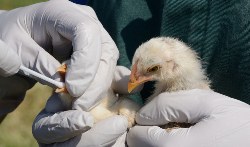Walter and Rosemary Brasch: A Bunnies' Tale
A Bunnies' Tale
by Walter and Rosemary Brasch
Forget everything you learned about Bre'er Rabbit, the brightest, most cunning of all animals in West African folklore and Joel Chandler Harris stories.
Disregard what you saw Bugs Bunny, the Brooklyn–born wise-cracking Br'er Rabbit spinoff, do to mentally-lame hunter Elmer Fudd and a host of cartoon characters.
Peter Cottontale, Peter Rabbit, and Roger Rabbit. Thumper, the March Hare, and The Easter Bunny. All are smarter in fiction than in real life. Even the average Playboy Bunny is brighter than the average rabbit.
Check out any list of animal intelligence rankings, and you'll see various monkeys and apes; Wolves, foxes, coyotes, and dogs; pigs, elephants, and horses; dolphins and whales; crows, parrots, and several other birds; and dozens of other animals, including a couple of invertebrates. Rabbits aren't even on most lists. Of course, the lists are made by humans, whose own intelligence is suspect most of the time.
We live in a rural area with a large backyard that is the home for several trees, bushes, shrubs, and flowers, as well as two dogs and one pot-bellied pig. Our yard is also the temporary home of uncountable visiting chipmunks, squirrels, birds, bats, toads, insects of every kind and—alas—rabbits.
For most of the year, rabbits of every size and age get water from our grass, food from our flowers and plants, shelter from our trees. Our playfully pacifistic dogs like to watch them, stalk them, and chase them, but the rabbits have always figured out how to escape. What they haven't figured out is how to build nests and take care of their young. And that presents our problem.
The gestation period for rabbits is about 30 days, and mother rabbits can mate the same day she delivers a litter of four to eight. Days before delivering her litter, the mother rabbit will usually prepare a nest, lining it with her own belly fur. She'll deliver the bunnies, and then hop away, perhaps to go to the store for a few items, off to visit friends, or to her job at the Bunny Emporium. Survival instinct has led mothers to seemingly abandon their nests, so as not to attract attention of predators, but will watch from afar and stop by in the early morning and late evening to nurse her babies, known as kits.
But rabbits being rabbits will build nests anywhere they like, often, protected by bushes, sometimes left in the open, where predators, including neighboring cats, find the young. A couple of times, bunnies built their nests in the outdoor dog house. Fortunately for them, the dogs don't use it because they have a 2,000 square foot air conditioned house that they allow humans to share.
Sometimes, because almost every kind of carnivore, including man, consider the timid, scared rabbits as a food source, the mother will never have the opportunity to return to the nest.
We have tried to help mother rabbits by giving better protection to their nests. While a few may argue that because rabbits are so skittish, humans should do nothing to a rabbit's nest because the mother may abandon it, we have not found this to be true.
We have taken abandoned kits to licensed wildlife rehabilitators who try to keep them alive until they can be released into protected game lands. But kits who have been orphaned within days of being born usually don't survive.
Survival is dependent upon cecotropes and colostrum. The mother excretes cecotropes—a bunch of grape-seed sized pellets that contain bacteria and fungi that contain nutrients—and then will reingest them. Cecotropes help protect the mother against pathogens. Somehow, the reingested cecotrope becomes a part of the colostrum, the mother's first milk, which contain nutrients, proteins, growth hormones, and antibodies to protect against infection. For kits that don't get that first milk, there are artificial alternatives. Sometimes, kits can be introduced to other lactating bunnies who may, or may not, become temporary surrogates. Sometimes, it's possible to create artificial colostrum—often, a mixture of kitty milk replacement, various other fluids, and freeze-dried colostrum. The mixture can be fed to the neonatal kit through a sterile syringe or mini-nippled bottle, but it is not a substitute for natural milk; most wild rabbits will still die, and those who live may often have a weakened internal structure.
And so it was that at the end of one summer, a mother bunny showed up in our backyard, put the smallest of belly hair into a small impression in the dirt previously dug by one of our dogs, dropped four newborns, and then scampered off. We never saw the mother, only four blind, deaf, hairless kits, each weighing about an ounce.
To leave the unprotected nest where it was would have meant certain death from exposure, predators, or unintentional curiosity by our dogs. We thought of what must have seemed to be a hundred ways to protect the nest—mini-fences, rocks, leaves, all with access to the mother. None would work. We called the wildlife rehabilitator who had helped us many times in the past. This time, she had no suggestions. If we brought them to her, the only thing she could do was to humanely euthanize them. If we left them where they were, they would die within hours. We knew it was seldom good to move nests, but we knew we had only one choice if there was to be any hope for the bunnies to live.
Carefully, we put them into a small box, added some leaves, and moved them to an area outside our house, protected by bushes, but in the path where rabbits normally go. Hopefully, their mother—or another mother—would see them and help raise them. We knew it probably wouldn't happen, but we hoped. It was the best we could do.
And then we shed a few tears.
Dumb bunnies.
[Assisting on this column was wildlife rehabilitator Kathie Guilfoose. Rosemary Brasch is a former secretary, Red Cross national disaster family services specialist, labor union grievance officer, and labor studies instructor. Walter M. Brasch is a university professor of journalism, social issues columnist, and the author of 17 books. His current books are 'Unacceptable': The Federal Response to Hurricane Katrina; and Sinking the Ship of State: The Presidency of George W. Bush, available from amazon.com, bn.com, and other stores. Sinking the Ship of State was a winner in the politics/social issues category of USA Book News awards, and a finalist in the Independent Book Publishing Professionals Group awards. His weekly column was this year's winner in contests sponsored by the Pennsylvania Press Club and the Society of Professional Journalists; his column received honorable mention in competition sponsored by the National Society of Newspaper Columnists. Forthcoming in September is the critically-acclaimed third edition of Sex and the Single Beer Can: Probing the Media and American Culture. You may contact him at brasch@bloomu.edu or through his website, www.walterbrasch.com]


 Gordon Campbell: On bird flu, AUKUS entry fees and Cindy Lee
Gordon Campbell: On bird flu, AUKUS entry fees and Cindy Lee Binoy Kampmark: Israel’s Anti-UNRWA Campaign Falls Flat
Binoy Kampmark: Israel’s Anti-UNRWA Campaign Falls Flat Peter Dunne: Luxon Gets Out His Butcher's Knife - Briefly
Peter Dunne: Luxon Gets Out His Butcher's Knife - Briefly Binoy Kampmark: Warring Against Encryption, Australia Is Coming For Your Communications
Binoy Kampmark: Warring Against Encryption, Australia Is Coming For Your Communications Gordon Campbell: On Fast Track Powers, Media Woes And The Tiktok Ban
Gordon Campbell: On Fast Track Powers, Media Woes And The Tiktok Ban Binoy Kampmark: Censorship Wars, Elon Musk, Safety Commissioners And Violent Content
Binoy Kampmark: Censorship Wars, Elon Musk, Safety Commissioners And Violent Content